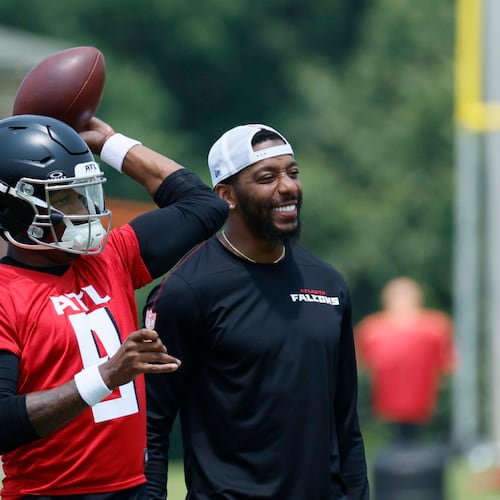With most NFL games going down to the wire, some proponents of analytic research believe that going for more two-point conversions can flip some of those close games.
The Falcons went 8-8 last season, losing three NFC South games by three, four and three points. They also had a one-point loss to San Francisco and a three-point loss to Indianapolis.
If they won those five close games, their record would have been a much different 13-3.
Such arithmetic is why teams like Pittsburgh, Green Bay and New Orleans are openly talking about going for more two-point conversions in 2016.
“They should be doing it more often,” said Brian Burke during a recent appearance on SiriusXM NFL radio.
Burke is the founder of the popular website AdvancedFootballAnalytics and one of the leading voices in NFL analytics. He joined ESPN as a senior analytics specialist in June 2015.
“The (conversion) chart they have now is really antiquated,” Burke said. “It was developed by Dick Vermeil back in the early 70s at UCLA for the college game. You can imagine all of the differences between the modern NFL to college football from the early 70s. It’s a different animal. That chart is pretty antiquated. It also doesn’t factor in the time.
“With the tools that we have today, we can do a much, much better job.”
The Falcons tried only three two-point conversions last season after 38 touchdowns (7.8 percent). They converted one (33 percent). The Steelers led the league with 11 two-point attempts after 45 touchdowns (24 percent).
With the NFL moving the extra-point attempt back to the 33-yard line, Burke believes teams should now go for two-point conversions up to 50 percent of the time.
But Falcons coach Dan Quinn isn’t sure going for two-point conversions all the time is a sound football concept.
“How many things are they going to do from the 2-yard line?’” Quinn said. “You score 50 touchdowns. What 50 two-point plays are you running from there?”
With the longer extra-point, Quinn does concede the two-point conversion play has a bigger role in the game.
“Like most things, knowing when you have an advantage, take it,” Quinn said. “Those guys like Mike (Tomlin), Sean (Payton) and Mike McCarthy are three coaches that I really respect a lot. If they have a decision about it, I’ll respect that. It might not be ours at the time. But that doesn’t mean I don’t respect it.”
Quinn respects the analytics position, but adds of the 2-point decision, “Sometimes, it’s gut.”
Analytics will likely take a while to gain a foothold in pro football.
“Football is a very conservative sport and I don’t mean that politically,” Burke said. “I mean that in terms of it’s a very, very complex. The tried-and-true is what’s relied upon.”
Some teams’ front offices have embraced the use of analytics, but coaches appear to be pushing back on the numbers.
“Coaches don’t like being told what to do by computer,” Burke said. “Leave the final decision in the coaches’ hand, but arm him with as much information as you can.”
The Falcons have an expanded analytics department, providing information vital to the draft process.
“We continue to grow as far as our approach and become more and more intellectual as far as how we are looking at things and presenting things to (Quinn),” Falcons general manger Thomas Dimitroff said.
One area where analytics has made strides is suggesting when teams should go for it on fourth downs.
“Fourth downs, we call it the low-hanging fruit of football analytics,” Burke said. “We really have plowed that territory very well.”
A proper decision can help out a team immensely.
“If you went by the numbers alone on fourth down, you could add, like, a half a win to teams,” Burke said. “So every other year, you could turn an eight-win team into a nine-win team. A 10-win team into an 11-win team. It doesn’t sound like a lot, but that’s the difference between the playoffs or not or getting bye or not, or playing on the road in a wild-card game.”
Quinn is fine trying to convert more fourth downs in the right situations.
“I think we went 17 times, which was third most,” Quinn said. “It was in the top five. So, I want to stay aggressive that way, when it’s the right decision. Sometimes, you can use the analytics. Sometimes, it’s right there (pointing to his stomach).”
Trailing in the San Francisco game by four points, Quinn elected to kick a field goal instead of going for a fourth-and-1 late in the game. The 49ers ran out the clock and the Falcons ended up losing 17-16.
“I learned that lesson this year,” Quinn said. “I had all of the numbers and sometimes you’ve got to go away from the numbers and go with your gut. Those are the ones where you say, ‘We’re going for it.’”
The situation came up again in the win over Carolina in Game 15. On fourth-and-9 from Carolina’s 36 with 1:35 to play, Quinn went for a field goal.
“Kick a field goal against Carolina to go ahead by a touchdown or not at the end of the game,” Quinn said. “Some people say, punt it and make them drive. My gut feeling said go for it.”
Shayne Graham made a 54-yard field to put the Falcons up 20-13.
“I didn’t do one where we lost a game and my gut said ‘OK, if it’s not fourth-and-1. Don’t go for it,’” Quinn said. (It was officially fourth-and-1, but the ball was closer to the 2-yard line vs. the 49ers.)
“There is a time for it,” Quinn said. “Real information and knowledge is power. But at the same time, it’s feel. The shift of the game may feel differently.”
About the Author
Keep Reading
The Latest
Featured



